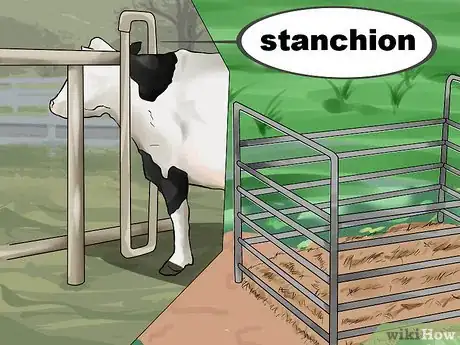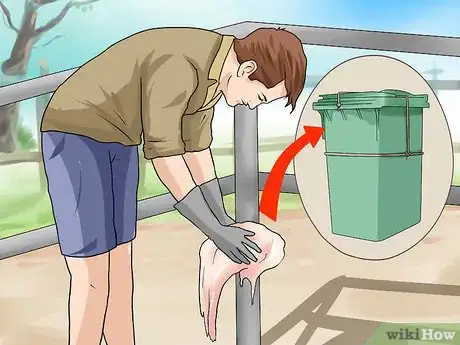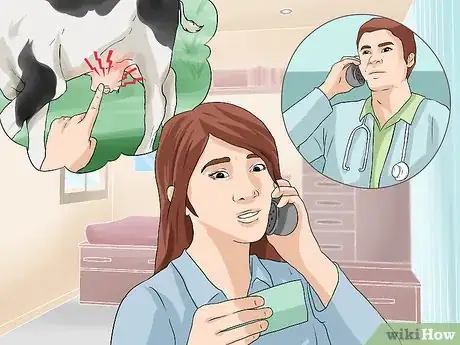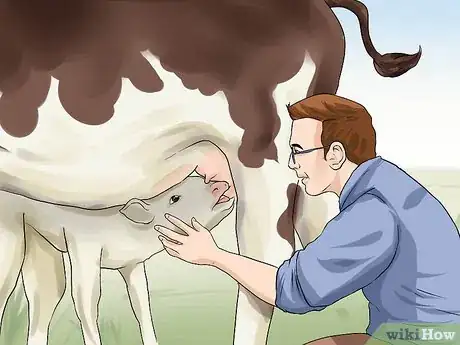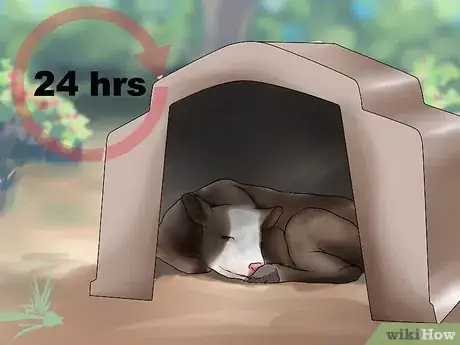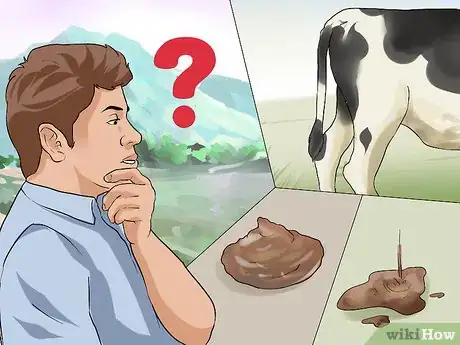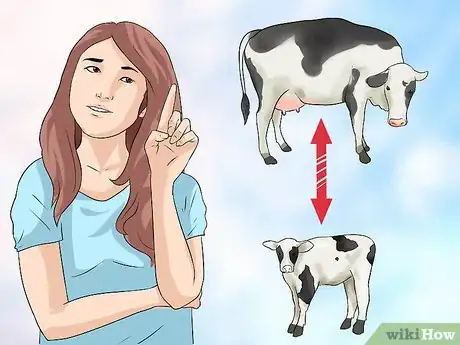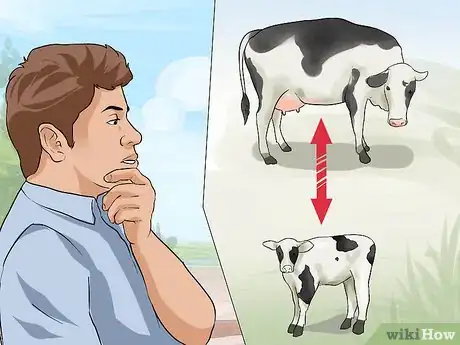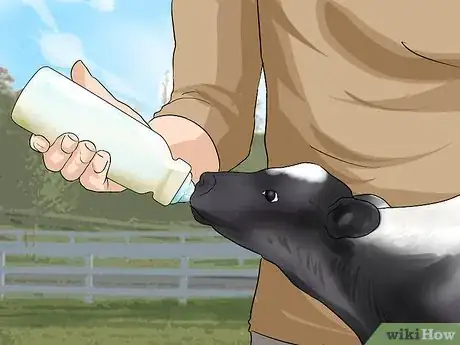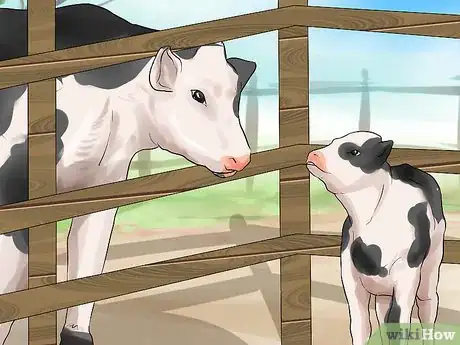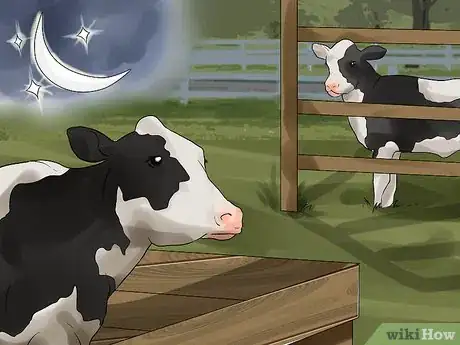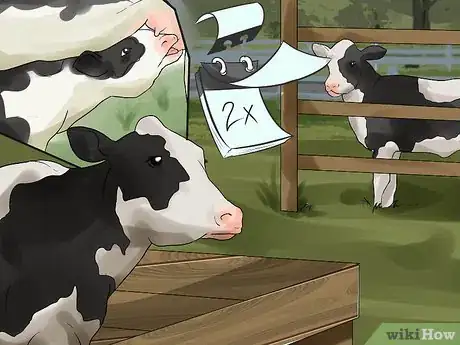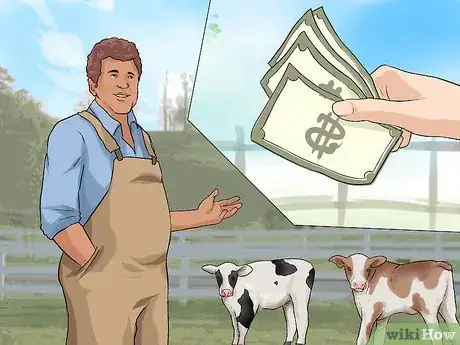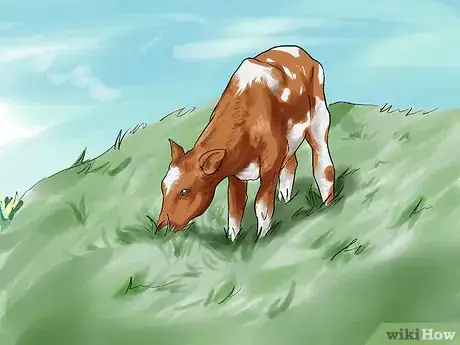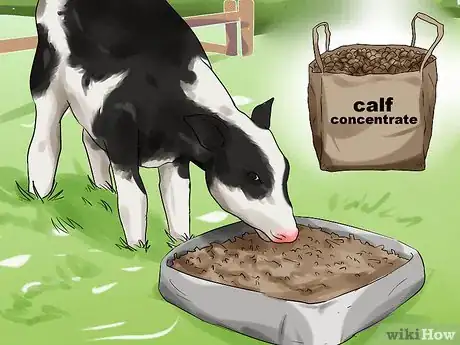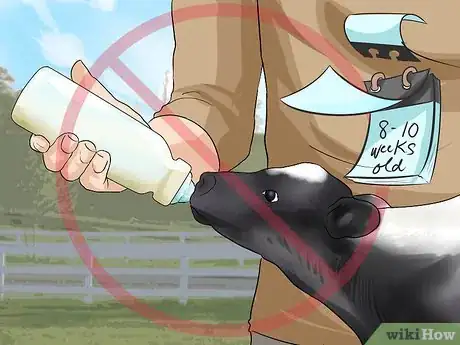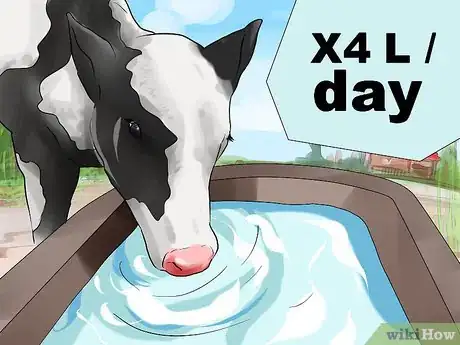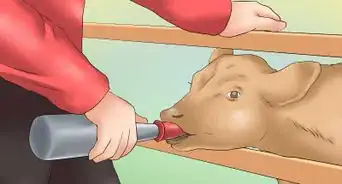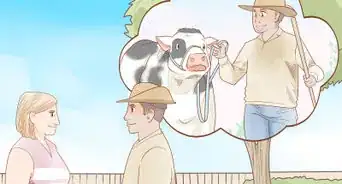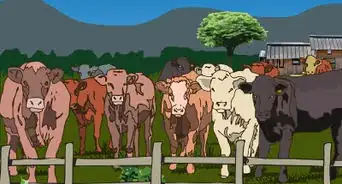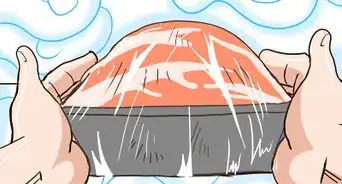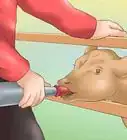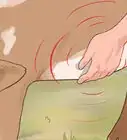This article was co-authored by wikiHow Staff. Our trained team of editors and researchers validate articles for accuracy and comprehensiveness. wikiHow's Content Management Team carefully monitors the work from our editorial staff to ensure that each article is backed by trusted research and meets our high quality standards.
This article has been viewed 49,923 times.
Learn more...
If you have a rural lot or a small hobby farm, you may be considering getting a cow or two so you can enjoy fresh milk and all the byproducts you can make from milk. While you can purchase adult cows for this purpose, you can also purchase calves shortly after they are born and raise them. If you have a slightly larger operation, you may even decide to breed the cows on your own.
Steps
Ensuring a Safe Birth
-
1Prepare a maternity pen for the cow. A maternity pen for the cow needs to be in a quiet part of your barn, in an area away from drafts. The area should also be clean, dry, well-lit, insulated, and with good air flow. Shortly before the cow gives birth, remove any soiled bedding and manure.[1]
- A maternity pen should be at least 3 metres by 3 metres in size (or 10 feet by 10 feet).
- When using bedding that consists of shavings or chopped straw, make sure the bedding layer is 2 to 3 inches thick.
- When using bedding that consists of long straw, make sure the bedding layer is 4 to 6 inches thick.
- It is vital that the calf is born in a clean area in order to prevent a navel infection and other diseases.<
-
2Be ready if the cow has trouble with calving. Some cows have trouble when calving and need your help. If you need to help your cow, you should make sure the maternity pen includes a stanchion that can secure your cow. It is best if the stanchion is lockable and near the ground to prevent injury to the cow (e.g. from being strangled).[2]Advertisement
-
3Remove the placenta from the maternity pen. After the calf is born, the placenta will be expelled from the cow’s body. When you see it come out, remove and dispose of it. It is not necessary for the cow to eat the placenta for nutritional purposes. Usually, while all of this is going on, the cow will be thoroughly cleaning her calf, which you should allow her to do.
-
4Care for your calf’s navel. Your calf’s navel can allow bacteria to get into her bloodstream, where the infection can work its way to her liver. Your calf’s navel should be dry, thin, and not swollen. If your calf’s navel does not meet these criteria, you should have your veterinarian come see your calf.[3]
- Immediately after your calf is born, you can dip her navel in iodine. Not only does this help dry out the umbilical cord, it helps prevent infection. A 20% iodine solution works best.
- For the first two weeks of your calf’s life, check her navel every day.
- If your calf experiences any type of pain when you touch her navel, this may also require a veterinarian visit.
- Also check to make sure your calf’s navel is not draining any liquid and doesn’t have a bad smell.
-
5Help the calf feed, if necessary. It is essential that a calf consumes colostrum within the first five hours of life. If your calf has any trouble feeding from its mother, you may need to physically help her by holding her up and showing her the teat.
- Colostrum is the liquid that is produced by the mother immediately before and after she gives birth. Colostrum contains antibodies that help the calf develop an effective immune system, which will eventually allow the calf to fight off infections and diseases.
- Note, if you purchase a calf from a feed lot or auction, it is possible the calf never had a first feeding from her mother and did not consume any colostrum.[4]
- Your calf should feed from its mother at least 3 to 4 times within the first 24 hours of her life.
Dealing with a Newborn Calf
-
1Move your calf to her own hutch. Unfortunately, calves can easily develop a number of different infections and diseases which can be fatal. In order to help prevent these infections and diseases, it is best to keep the calf in a hutch or pen of its own. Not only does this allow you to monitor the calf, it prevents multiple calves (if you have more than one) from having to compete for food when feeding.
- Move your calf to a pen or hutch of her own after she has been with her mother for 24 hours and has fed 3 or 4 times.
- Once the calf is 2 months old, she can be moved back to a group pen with her mother or other cows.
- Each hutch should always have fresh, clean, and dry straw for bedding.
- Note, this step is an absolute requirement if your eventual plan is to use the calf for dairy production. If you simply want to raise the calf for the production of beef, the calf does not need to be separated from her mother.
-
2Observe your calf’s feces and urine. While your calf is in her hutch, keep an eye on her feces and urine, as well as her food intake. Specifically, watch for any changes in how much food your calf consumes, and the consistency and frequency of feces and urine production. If you notice any changes, consult with your veterinarian.[5]
-
3Decide if your want to completely or partially wean your calf. If you have purchased a calf and do not have the mother, your only option is to do a complete weaning. If the calf was born on your property, and the mother is around, you can also consider doing partial weaning.
- Complete weaning means that the cow and calf are separated 24 hours after birth and do not come into contact with each other again.
- Partial weaning is only possible if the cow and calf are in the same location. Partial weaning means that the cow and calf stay in contact with each other, but the calf is only allowed to feed from the mother at certain times.
-
4Understand the pros and cons of complete weaning. Complete weaning means that the calf and cow are separated completed and are never put in the same place again. If you have purchased a calf without its mother, this is your only option. However, if you have the ability to choose between complete and partial weaning, here are a few pros can cons to keep in mind regarding complete weaning:[6]
- This option is useful if you are already using the calf’s mother for dairy production and do not want the calf to consume that milk.
- This option is sometimes better in the long-term because complete weaning allows your calf’s stomach to develop quickly so the calf can eat dry feed and grass. A calf that is able to have as much of her mother’s milk as she wants won’t be as interested in dry food.
- Note, if you sell your milk and the cost of buying and using milk replacers for your calf is more expensive than selling your milk, it may be better to partially wean your calf.
-
5Use milk replacers to completely wean your calf. A calf that is being completely weaned will need to consume milk replacers before it can be fed dry feed. Unfortunately, powdered milk replacers can sometimes cause a calf to get diarrhea, so be observant of her feces. And, the equipment used to feed your calf must be kept clean and disinfected at all times.
- From the time you separate the calf from her mother, you should start to feed her two bottles of milk or milk replacer a day.[7]
- Milk replacer comes in large sacks of powder and needs to be mixed with water before given to the calf. Follow the instructions on the milk replacer package for the exact mixing instructions.
-
6Allow the cow and calf to stay together for partial weaning. If your calf is being partially weaned, you will be able to keep the cow and calf together. They can either be together in a large pen or paddock, or they can be placed in separate small pens beside each other. The important part of partial weaning is that the calf gets to interact with her mother via touch, sight, and sound.
-
7Separate the cow and calf only at night. During the daytime, the cow and calf can be together in a pasture or pen. While together, the calf can feed from the cow anytime it wants. At night, both the cow and calf are brought into the barn and put into separate pens. The pens should be right beside each other, but the calf should not be able to reach trough the pen to feed from the cow.
- While at pasture during the day, the calf should start to graze on its own. This is helpful as it speeds up the development of calf’s stomach and will get her use to grass and forage.
-
8Put the cow and calf in separate pens if the cow is milked twice a day. If the cow is milked twice a day, it is best to keep the cow and calf near each other in smaller pens where the calf cannot reach the cow. When the cow is milked in the morning and evening, do not allow her to be completely milked. Leave some of the milk for the calf. Once milking is done, the calf can be allowed near the cow to feed. In-between milkings, the calf can be hand-fed fresh hay or grass, fed concentrates (dry feed), and given water.
- In this setup, the cow and calf are not allowed in the same pen or pasture together and the calf is not allowed to free-feed from the cow.
Raising a Calf You Purchased
-
1Purchase a healthy calf. If you want a calf for the purpose of dairy production, the best place you can buy that calf is from a daily farm. You can also purchase a calf at an auction or at a feed lot.[8]
- Buying a calf from a dairy farm is good because you know that farm is concerned about having healthy cows for milk production. Therefore, it is likely that the calf was fed colostrum for at least the first 24 hours.
- Unfortunately, it is unlikely that you will know much about the calf’s history if you purchase her from an auction or feedlot, and there is no guarantee that the calf has been given colostrum.
- One way to test if the calf was already given colostrum, and therefore had been feeding from her mother, is to see if she will suck your fingers.
-
2Buy bottled colostrum from a dairy farm. Colostrum can be collected from a cow who has just given birth and stored in the freezer. For calves who do not have access to their mother, this colostrum can be fed to them via a bottle and can help them remain healthy.
- For calves who are raised with their mothers, saving some colostrum is still helpful. Unfortunately, some cows die shortly after giving birth, which will prevent the calf from receiving enough colostrum from her mother. Colostrum from another cow can be used instead.
-
3Allow your calf to nibble or graze any grass it wants. In order for a grown cow to be able to consume grass, she needs her stomach to be able to digest that grass. In order to ensure a calf grows up to be able to digest grass, she should be allowed to eat all the grass she wants from the day she is born.
- If you calf is penned in a smaller area with no grass, you can tie clippings of grass to the fence of the pen for your calf to nibble. Do not place the grass on the ground.
-
4Start feeding your calf concentrate. Concentrate is essentially dry cow feed. Concentrate should be available to the calf from the start, but you may not notice her eating it right away. A calf should, however, be eating a little concentrate regularly by the time she is a month old.
- Provide a small amount of concentrate at the beginning and observe how much the calf eats.
- Once the calf starts to eat the concentrate, add a little more to her bowl the next day.
- Remove any uneaten concentrate on a daily basis.
-
5Stop feeding your calf milk or milk replacers. By the time your calf is two weeks old, she should be eating grass and concentrate on her own. However, the milk or milk replacer cannot be taken away until you are sure she’s getting enough food via other means. Just like you slowly introduced more concentrate to your calf’s diet, slowly remove the milk from her diet.
- By the time your calf is 8 to 10 weeks old, she should no longer be consuming milk or milk replacers.
- If the calf is being bottle fed, a good way to reduce the amount of milk your calf consumes is to slowly replace some of the powder in the milk replacer with water. Eventually, the bottle will be all water and the calf will be weaned off milk.[9]
- This method should take around a week to complete.
-
6Ensure your calf always has fresh water. Your calf will probably start drinking water when she is 1 to 2 weeks old. In order to stay healthy and hydrated, your calf must consume water regularly. By the time your calf is 6 weeks old, she should be drinking 4 litres of water a day.
- Fresh and clean water must be given to your calf. Do not allow the water trough to become dirty or filled with other material.
- Note, if your calf is sick (especially if she has a fever) and will not drink water on her own, you may need to call your veterinarian and place a tube into her stomach in order to give her water. If you do not do this, your calf will become dehydrated and probably not survive.
Community Q&A
-
QuestionWhat if the calf doesn't know how to suck on bottle? What should I do?
 Community AnswerYou have to teach her about sucking from a bottle by taking the formula and the nipple from the bottle, squeezing some into her mouth and over her nose and mouth so that she gets a taste of it.
Community AnswerYou have to teach her about sucking from a bottle by taking the formula and the nipple from the bottle, squeezing some into her mouth and over her nose and mouth so that she gets a taste of it. -
QuestionAt what age is a calf ready to produce milk?
 Community AnswerA calf is not ready to produce milk at all until she bears young at about 2 years of age. By that age, that calf is no longer considered a calf, but a cow or a first-calf heifer.
Community AnswerA calf is not ready to produce milk at all until she bears young at about 2 years of age. By that age, that calf is no longer considered a calf, but a cow or a first-calf heifer. -
QuestionWhy are vaccines needed for developing calves?
 Community AnswerVaccines are a good idea for any developing animals, including humans. Vaccines help the animal's body learn about a specific virus or disease and how to fight it off. An animal that is exposed to a virus for which there is a vaccine, but which was not provided, will likely have a much harder time fighting off the virus. Vaccines for calves differ by region based on what viruses and diseases are present in the area. In order to determine which vaccines your calf should have, consult your veterinarian.
Community AnswerVaccines are a good idea for any developing animals, including humans. Vaccines help the animal's body learn about a specific virus or disease and how to fight it off. An animal that is exposed to a virus for which there is a vaccine, but which was not provided, will likely have a much harder time fighting off the virus. Vaccines for calves differ by region based on what viruses and diseases are present in the area. In order to determine which vaccines your calf should have, consult your veterinarian.
Warnings
- Calves that are used for dairy production need to be treated very differently than cows used for beef production. While you can eventually slaughter and eat a cow used for dairy production, you should not switch a cow from being used for beef production to dairy production.⧼thumbs_response⧽
References
- ↑ http://calfcare.ca/newborn-care/maternity-pens/
- ↑ https://www.beefmagazine.com/calving/when-should-you-call-vet-difficult-calving
- ↑ http://calfcare.ca/newborn-care/navel-care/
- ↑ http://www.motherearthnews.com/homesteading-and-livestock/raising-bottle-calves-zmaz78mazjma.aspx
- ↑ http://www.infovets.com/books/dairy/DairyDB/A/Dairy%20Care%20Practices.htm
- ↑ http://www.infovets.com/books/dairy/DairyDB/A/Dairy%20Care%20Practices.htm
- ↑ http://www.motherearthnews.com/homesteading-and-livestock/raising-bottle-calves-zmaz78mazjma.aspx
- ↑ http://www.motherearthnews.com/homesteading-and-livestock/raising-bottle-calves-zmaz78mazjma.aspx
- ↑ http://www.motherearthnews.com/homesteading-and-livestock/raising-bottle-calves-zmaz78mazjma.aspx

